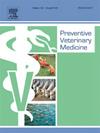Evaluating machine learning classifiers and explainability for monitoring cow behaviour with wearable nose rings
IF 2.4
2区 农林科学
Q1 VETERINARY SCIENCES
引用次数: 0
Abstract
Wearable technologies are revolutionizing precision livestock monitoring by allowing continuous real-time monitoring of animal behaviour. This study investigates and evaluates the use of machine learning techniques to classify dairy cow behaviours using tri-axial accelerometer data collected from novel wearable nose ring sensor. The raw dataset initially included five distinct behaviours: Feeding, Ruminating, Standing, Lying and Walking. However due to data imbalance and data limitations we refined the classification to three core categories: Feeding, Rumination and Walking. While previous studies on this dataset focused solely on Long Short-Term Memory(LSTM) network, the comparative potential of other models remained unexplored. To address this gap, we performed a comparative study on multiple classifiers, including Random Forest (RF), Artificial Neural Network (ANN), Gated Recurrent Unit (GRU) and a hybrid Convolutional Neural Network with LSTM (CNN-LSTM). The obtained results showed that GRU model performed well with an accuracy of 97.78 %, followed by CNN-LSTM, ANN and RF which scored 97.78 %, 68.27 % and 67.6 % respectively. To enhance model transparency, Explainable AI techniques were utilized. SHAP and LIME were utilized to showcase feature importance and interpretability of these models. These findings showcase the effectiveness of deep learning models (GRU, CNN-LSTM) and emphasizes the importance of model explainability in precision livestock management.
评估用可穿戴鼻环监测奶牛行为的机器学习分类器和可解释性
可穿戴技术通过允许对动物行为进行连续的实时监测,正在彻底改变精确的牲畜监测。本研究利用从新型可穿戴鼻环传感器收集的三轴加速度计数据,调查并评估了机器学习技术在奶牛行为分类中的应用。原始数据集最初包括五种不同的行为:进食、反刍、站立、躺着和行走。然而,由于数据不平衡和数据限制,我们将分类细化为三个核心类别:喂养,反刍和行走。虽然之前对该数据集的研究仅集中在长短期记忆(LSTM)网络上,但其他模型的比较潜力尚未得到探索。为了解决这一差距,我们对多个分类器进行了比较研究,包括随机森林(RF)、人工神经网络(ANN)、门控循环单元(GRU)和LSTM混合卷积神经网络(CNN-LSTM)。结果表明,GRU模型的准确率为97.78 %,其次是CNN-LSTM、ANN和RF,分别为97.78 %、68.27 %和67.6% %。为了提高模型的透明度,使用了可解释的人工智能技术。利用SHAP和LIME来展示这些模型的特征重要性和可解释性。这些发现展示了深度学习模型(GRU, CNN-LSTM)的有效性,并强调了模型可解释性在精确牲畜管理中的重要性。
本文章由计算机程序翻译,如有差异,请以英文原文为准。
求助全文
约1分钟内获得全文
求助全文
来源期刊

Preventive veterinary medicine
农林科学-兽医学
CiteScore
5.60
自引率
7.70%
发文量
184
审稿时长
3 months
期刊介绍:
Preventive Veterinary Medicine is one of the leading international resources for scientific reports on animal health programs and preventive veterinary medicine. The journal follows the guidelines for standardizing and strengthening the reporting of biomedical research which are available from the CONSORT, MOOSE, PRISMA, REFLECT, STARD, and STROBE statements. The journal focuses on:
Epidemiology of health events relevant to domestic and wild animals;
Economic impacts of epidemic and endemic animal and zoonotic diseases;
Latest methods and approaches in veterinary epidemiology;
Disease and infection control or eradication measures;
The "One Health" concept and the relationships between veterinary medicine, human health, animal-production systems, and the environment;
Development of new techniques in surveillance systems and diagnosis;
Evaluation and control of diseases in animal populations.
 求助内容:
求助内容: 应助结果提醒方式:
应助结果提醒方式:


